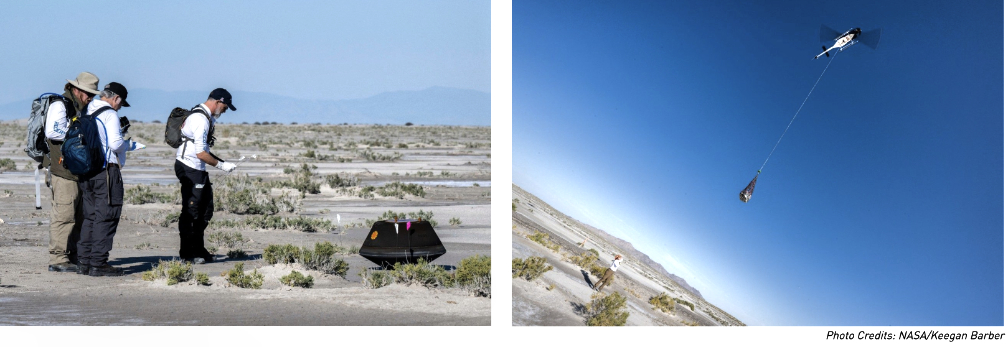
Credits: NASA/Keegan Barber
Following a rapid and red-hot descent through Earth’s atmosphere, NASA’s OSIRIS-REx sample return capsule touched down in the desert at 8:52 a.m. MT on September 24th, returning NASA’s first-ever, asteroid sample.

Credits: NASA
The capsule is estimated to hold about a cup of material from Bennu, a carbon-rich asteroid. Scientists hope it will teach us more about the origin of organics that led to life on Earth and help us to better understand planet formation.
Just prior to landing, the capsule entered the atmosphere traveling more than 27,000 mph and then gently landed in the sands of the U.S. government’s Utah Test and Training Range.
A specialized recovery team led by Lockheed Martin [NYSE: LMT] – the company that designed, built and currently flies the mission for NASA – comprising representatives from NASA’s Goddard Space Flight Center, NASA Johnson Space Center, the University of Arizona, then secured the capsule. In total, about 60 people from NASA, the University of Arizona, Lockheed Martin and range personnel took part in the capsule landing and recovery efforts, plus a team of about 25 engineers operating the spacecraft from Lockheed Martin’s Mission Support Area in Denver.

“The landing was safe, recovery was a huge success, and we’re thrilled that the next phase of this mission can now begin. This particular sample return is monumental – scientists are about to open a time capsule with some of the earliest history of our solar system inside.” — Kyle Griffin, vice president and general manager of Commercial Civil Space at Lockheed Martin
After approaching the capsule landing area in helicopters, the recovery team carefully searched for any hazardous material, sampled the neighboring soil, wrapped the 100 lb capsule in protective material, and attached it for transport with via helicopter to an on-site cleanroom at the range. There, the sample is being processed for shipment on a military aircraft to curation team members at NASA Johnson in Houston, Texas, who will make it available for study.
The OSIRIS-REx mission pioneered key technologies relevant to the future exploration of small bodies in our solar system, beyond its immediate follow-on mission. They include:
Specific techniques for operating in microgravity
Autonomous guidance to the surface of a small body with Natural Feature Tracking
Unique sample collection from an asteroid, with the Lockheed Martin-invented, reverse-vacuum Touch and Go sample Acquisition Mechanism (TAGSAM) device
Next Stop: Apophis
Following today’s successful landing and showcase of key technologies, OSIRIS-REx will now be dubbed OSIRIS-APEX and enter its extended mission phase, beginning its journey to its follow-on mission target: near-Earth asteroid Apophis.
To date, OSIRIS-REx’s major mission milestones include:
Launching on September 8, 2016, from Cape Canaveral Space Force Station.
Arriving at Bennu on December 3, 2018, where it conducted a two-year detailed survey of the asteroid.
Extracting a sample from the asteroid by “tagging” it on Oct. 20, 2020.
Departing the asteroid to head back to Earth on May 10, 2021.
Within an hour and a half, the capsule was transported by helicopter to a temporary clean room set up in a hangar on the training range, where it now is connected to a continuous flow of nitrogen.
Getting the sample under a “nitrogen purge,” as scientists call it, was one of the OSIRIS-REx team’s most critical tasks today. Nitrogen is a gas that doesn’t interact with most other chemicals, and a continuous flow of it into the sample container inside the capsule will keep out earthly contaminants to leave the sample pure for scientific analyses.
The returned samples collected from Bennu will help scientists worldwide make discoveries to better understand planet formation and the origin of organics and water that led to life on Earth, as well as benefit all of humanity by learning more about potentially hazardous asteroids.
“Congratulations to the OSIRIS-REx team on a picture-perfect mission – the first American asteroid sample return in history – which will deepen our understanding of the origin of our solar system and its formation. Not to mention, Bennu is a potentially hazardous asteroid, and what we learn from the sample will help us better understand the types of asteroids that could come our way. With OSIRIS-REx, Psyche launch in a couple of weeks, DART’s one year anniversary, and Lucy’s first asteroid approach in November, Asteroid Autumn is in full swing. These missions prove once again that NASA does big things. Things that inspire us and unite us. Things that show nothing is beyond our reach when we work together.” — Bill Nelson, Administrator, NASA
The Bennu sample – an estimated 8.8 ounces, or 250 grams – will be transported in its unopened canister by aircraft to NASA’s Johnson Space Center in Houston on Monday, September 25th. Curation scientists there will disassemble the canister, extract and weigh the sample, create an inventory of the rocks and dust, and, over time, distribute pieces of Bennu to scientists worldwide.
